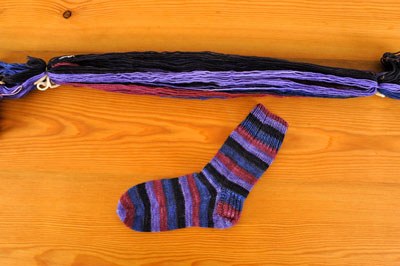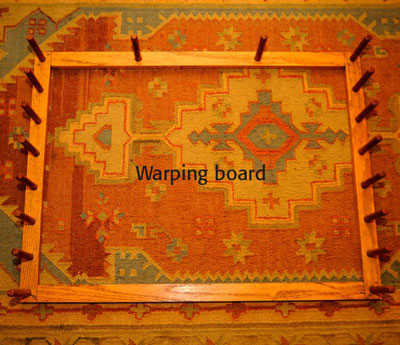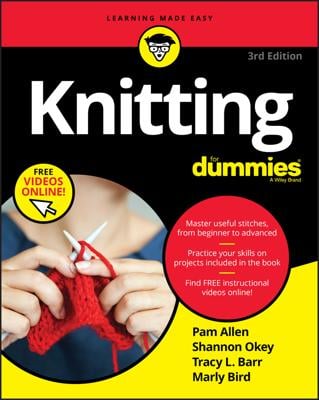Long color repeats are the secret to creating stripes in this project. For smaller projects, such as socks or scarves, you can paint a yarn dyed in a succession of striping colors by using long segments of solid colors in very long repeats. The knitted garment appears to be knit from multiple yarns of different colors, but the color work is all done using a paint brush and some color planning.

It takes at least two knitted rows in a sock to form a stripe—with each row using roughly 30 inches (76.2cm) of yarn.
This demonstration dyes a mammoth skein of a wool and nylon blend yarn to create one pair of socks striped in four colors. Begin by gathering these materials:
Superwash sock yarn on a cone, approximately 1,700 yards/1 lb.
WashFast dyes: Colonial Blue 401, Navy 413, Boysenberry 811, Lavender 812; 1 teaspoon (2.5g) of each color mixed with 1 cup (250ml) boiling water
Superclear dye thickener
Citric acid crystals
Synthrapol
White cotton string
Warping board
Yardage counter
4 foam brushes
Yarn ball winder
Plastic wrap
Enamel canning pot with lid and rack
Pie plate
4 Pyrex measuring cups
Sponges
Paper towels

It’s helpful to have a long table for painting this skein. Each band of color will be 4 yards long.
Dyeing is a fun, creative process, yet dyers must take safety seriously. Dye materials are safe to use as long as you follow the supplier’s instructions and some basic precautionary guidelines. The misuse or mishandling of dyes and materials used in dyeing could lead to harmful results such as allergic reactions if the dye comes in contact with your skin or if you inhale dye powder. If you are pregnant or lactating, consult the dye supplier regarding safety.
Apron
Rubber, latex, or nitrile gloves
Insulated gloves
Disposable particle mask
Dual cartridge respirator mask filled with acid gas cartridges
Safety glasses
Follow these safe practices for best results:
Never use your dyeing tools for food preparation. Label all tools DYE USE ONLY so no one will ever mistakenly use them for another purpose.
Never eat, drink, or prepare food while you are dyeing.
Keep children and pets out of the room while dyeing and store all dyeing products out of reach of children and pets.
Follow supplier instructions for dye products, which may vary.
When storing unused dye solutions, be sure to label containers clearly (especially if reusing beverage containers) and store them well out of reach of children.
Keep your workspace free from clutter and tripping hazards.
Take care when lifting large heavy pots of water. Never attempt to move a heated dye bath. Use pot holders if you must adjust the position of a dye pot.
Wear insulated gloves, safety glasses, and a respirator mask when stirring or manipulating fibers in the dye pot.
Always allow fibers to cool completely before handling.

